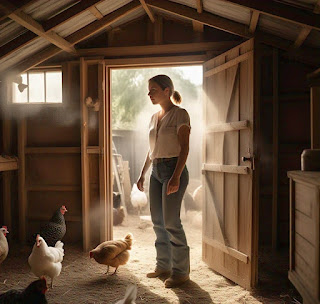Overheating in chicken coops is a common and dangerous problem for poultry keepers, especially during the summer months. When coop temperatures rise above comfortable levels, it can lead to stress, reduced egg production, illness, and even death among your birds. Proper ventilation is not just about comfort—it’s a matter of health and productivity.
In this comprehensive guide, we'll explore how to rapidly improve airflow in your coop, reduce internal temperatures, and create a healthier environment for your flock.
☀️ Why Is Airflow So Important in a Coop?
Airflow in a chicken coop helps to:
- ❄️ Regulate temperature: Proper airflow keeps heat from building up inside.
- ♻️ Remove excess moisture: Chickens produce humidity through breathing and droppings.
- 💨 Reduce ammonia buildup: Waste produces ammonia which can irritate your chickens' lungs and eyes.
- 🌳 Maintain oxygen levels: Fresh air improves overall bird health.
- ⚡️ Prevent respiratory issues: Good ventilation protects against diseases like CRD (chronic respiratory disease).
🏡 Signs Your Coop Has Poor Ventilation
- Birds panting or holding their wings out
- Strong ammonia odor
- Wet bedding or condensation inside the coop
- High humidity levels
- Slow growth and reduced egg laying
- Chickens gathering at vents or windows
If you observe any of these, it’s time to take urgent action.
🔥 Dangers of Overheating in Chickens
Overheating isn’t just uncomfortable for chickens—it can be fatal. Chickens don't sweat; instead, they rely on panting and wing-spreading to cool down. If the coop remains too hot:
- ⚠️ Heat stress can occur, leading to disorientation, weakness, and collapse.
- ☕ Egg production drops or stops entirely.
- 🛌 Mortality rates increase during extreme heat events.
The sooner airflow is addressed, the better your chances of maintaining a productive flock.
❄️ How to Improve Coop Airflow Immediately
Let’s explore fast and effective solutions to increase ventilation and airflow:
1. ⚠️ Open All Vents and Windows
Start by opening any existing vents, windows, or doors during the day and night (if safe) to allow cross-breezes to flow through the coop. The key is creating openings at both the top and bottom to allow hot air to escape and cool air to enter.
2. ☁️ Install More Ventilation Points
If the coop only has one or two small vents, it's not enough. Consider adding roof ridge vents, side vents, or installing a turbine vent that pulls air out continuously.
3. ✈️ Use Fans for Mechanical Ventilation
A small, solar-powered or battery-operated fan can be mounted near the top of the coop to exhaust hot air. Larger setups can use inline duct fans for pulling air through.
4. 🚪 Install a Screen Door
Adding a screen door to the entrance allows you to leave the main door open for long periods without letting predators in.
5. 🌡️ Shade the Coop
Install a shade cloth over the roof or plant fast-growing vines along the coop exterior. Keeping sunlight off the coop can lower inside temps by up to 10°F (6°C).
6. 🏠 Raise the Coop Off the Ground
Elevating the structure lets air flow underneath, helping to cool it from the bottom up. A 1-2 foot rise is typically ideal.
7. 💨 Remove Solid Barriers Inside
If there are internal walls or nesting boxes that block airflow, consider adjusting their orientation or replacing them with slatted dividers.
📈 Long-Term Design Solutions for Better Airflow
If you're planning a new coop or doing major renovations, keep airflow top of mind:
- Cross-ventilation: Position vents on opposite walls for maximum circulation.
- High ceilings: Hot air rises—higher ceilings help it escape.
- Roof angle: A sloped or gable roof can improve upward airflow.
- Insulated roof: Reduces internal heat gain in hot weather.
- Strategic coop placement: Build your coop where prevailing winds can assist in ventilation.
❄️ Cooling Tips for Extremely Hot Weather
Even with good airflow, extreme temperatures can require extra help:
- Freeze water bottles and place them around the coop.
- Mist the ground lightly to reduce ambient temperature.
- Place shallow water dishes in shaded areas.
- Consider installing a misting system or swamp cooler.
- Provide dust bathing areas with cool, dry sand.
♻️ Natural Cooling Enhancements
- Vines and climbing plants like beans, cucumbers, or grapevines provide natural shade.
- Reflective roofing materials bounce sunlight away.
- Water features (like a mini pond) nearby can reduce microclimate heat.
❓ Common Questions About Coop Cooling
Q1: Can I use an air conditioner in the coop?
While possible, it’s generally not energy-efficient. Proper ventilation and shade are better long-term.
Q2: Are misters safe?
Yes, if used responsibly. Avoid over-saturating the bedding to prevent mold.
Q3: Can chickens overheat at night?
Yes. If airflow stops completely and ambient temps remain high, chickens may struggle.
📆 Seasonal Airflow Management
- Spring: Begin checking for airflow obstructions.
- Summer: Maximize open-air flow; install fans if needed.
- Fall: Begin closing vents gradually at night.
- Winter: Use adjustable vents to balance warmth and air exchange.
🙏 Final Thoughts: Keep It Breezy, Keep Them Healthy 🌬️
A well-ventilated coop is critical to your chickens' health, happiness, and productivity. From quick fixes like adding fans and vents to long-term upgrades like raising the coop and shading it naturally, the strategies in this guide will help you keep temperatures manageable even during extreme heatwaves.
Remember: if it feels stifling inside your coop to you, it’s already dangerous for your birds. Act fast, monitor often, and create an environment where fresh air flows freely—your chickens will reward you with strong growth and consistent egg production.
🎨 Ready for More?
Need help designing a better coop or choosing the right ventilation setup for your region? Drop your questions below or contact us for personalized advice!
Stay cool, and happy hatching! 🌞🐔

